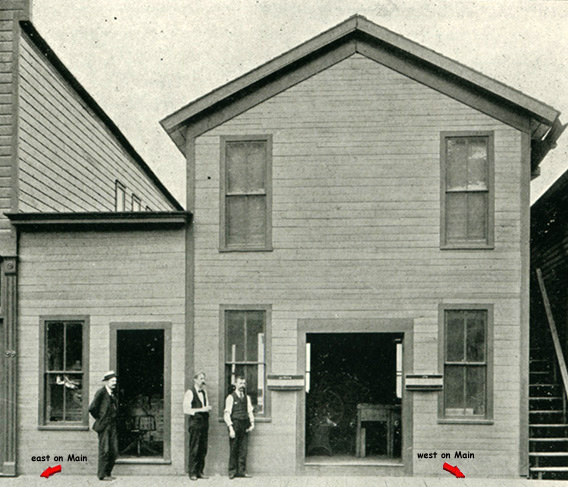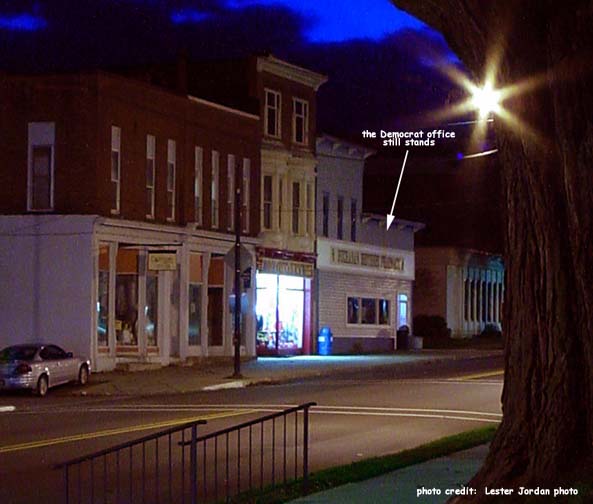Ross Knapp Writes about Olden Times in
Smethport
July 29, 1937
The Democrat has received the
following interesting reminiscences from Justice of the Peace Ross
K. Knapp of Kane, former well known Smethport newspaper man, in which
he recalls facts and figures of the food old days here:
Kane, Pa.
Russell R. Lindsley, Editor,
McKean County Democrat,
Smethport, Pa.
Dear Russ:
Reading recent articles in your newspaper has made me reminiscent
and I wonder if anyone cares to know what Smethport was like 50 or
more years ago. As a kid, eight years old, I started selling papers
and sometimes rembrances of those days come to me with keen intensity.
The big event of the evening in those days was when the bus made its
final trip of the day from the B., M.Y. & P. station at East Semthport.
Jim McGuire was the bus driver in the particular interval of which
I am writing, and right here let me state that I am going to use the
names known best to me – nicknames, perhaps, and all without
quotation marks. When the bus drew up at the Wright House with a wild
western flourish handed down from stage coach days, two or three drummers
would alight to be greeted beamingly by B. F. Wright, the proprietor
or “mine host” Wright as old newspaper writers insisted
on calling him. Archie Durke, the colored porter, would assist in
unloading the drummers’ trunks (perhaps fro the enlightened
generation I had better explain that a drummer was a traveling salesman)
and then the bus would proceed to its next stop, the Grand Central.
Here, travelers would be greeted by Frank Taylor, landlord, and a
similar scene with different cast would be enacted as the Wright House.
However, it is with the arribals at the latter hotel, with which I
was most familiar as it was here the newspapers were tossed down by
the bus driver to the waiting newsies. Billy Shoemaker, Ernie Theetge
(nephew of B.T. Downey) Bernie Crandall, (nephew of the late A. B.
Armstrong), were my main cohorts at that time, but there were long
intervals when I was the town’s sole newsboy. The curse ofprinter’s
ink had me even at that tender age, and eight years later I graduated
from a newsie to a printer’s devil in the old Miner office on
Church street, with the late Lucius Rogers as my boss.
Clustered around the hotel when the bus drew up was a group, that
of course changed somewhat from night to night, but that nearly always
was partially composed of B. F. Wright, Shorty Wright, his son; who
conducted the hotel livery stable, afterward owned for many years
by E. T. Daly; Ren Ingley, the bartender; Wallace Ostrander, Gilbert
Lyman, Frank Mackus, Ed Waller, Job Gifford and his lantern, and Mr.
Gifford sure needed that lantern for the long, dark trip to his home
“across the creek.” These men were served with their newspapers
and generally each took one or more extras for their neighbors, then
the nightly route began for the newboys.
Directly across the street was the home of Andurs Williams. Diagonally
across to the east was the home of Mrs. Bennett and son, Charles.
East at the corner of Hill Street was the home of James McNulty and
family and his tailoring establishment, and then there were but very
few houses between that point and the East Smethport bridge.
Where the Colonial Hotel is now located was the home of A. D. (Bucky)
Burbank. Across Mechanic street from the Wright House was the Kittridge
Opera House, then almost a new building. Harry Well’s drug store
and Mrs. Joe Reilly’s millinery store, occupied the Main street
frontage, while on the Mechanic street side Albert Anderson and Lawerence
Norberg had a shoe repair shop, and a barber shop run by a man named
Bischey. Down Mechanic street was Dick Hussey’s residence, and
Don Beatty had a bakery where D. M. Brasted is now located, next to
the Eaton homestead.
Going uptown on Main street we served Linn Mason’s hardware
store, Robert King, across the street, then Vickery’s grocery
(afterward Jay Abbey’s), Specht & Sasse, Harry Wilson’s
grocery, Mrs. T. D. Nash, millinery, Rooney’s meat market. ON
the other side was Tracy’s store and the Bergstresser house
(now I believe, occupied by J. J. Johnston) and on the same side of
the street the Rockwell House, which became the Chatauqua Hotel and
later the Hotel Imperial. ON the south side E.L. Keenan’s home,
the Hamlin Bank, and then the Grand Central. Here we generally found
trade brisk as it was a gathering place for residents of the western
part of the borough, but I do not recall the names as clearly as those
at the Wright House. Then there was the Picard House, Chet King’s
billiard room, George Williams’ meat market, Gleason & Lemmier’s
harnass store, M.L. Armstrong’s jewelry and toy store and A.B>
Armstrong’s drug store.
On the opposite side of the street was M.A. Sprague’s hardware
(wonder whatever become of Bob Sprague, a dear friend of mine), Dr.
H.L McCoy’s drug store, H.W. Rubin’s clothing store and
Brownell Brothers’ grocery. Then the court house and across
from the store, office and lodge building, I believe D.C. Young’s
store was in this building at the time of which I am writing, and
back from the street F.B. Dean’s livery stable and the big skating
rink, J.C. Hamlin’s hardware store was a Main and Church streets.
The McKean Democrat was west of the Hamlin Hardware on Main street.
Clark Wilson was the editor. This building was inter moved down Main
street, ext to Attorney E. L. Keenan’s property.
My route up this way generally ended at the home of P. Ford on Church
street, and shall I ever forget Mr. Ford? He used to take the Buffalo
Evening News, then one cent a copy, but he used to give me tem cents
extra every Saturday night, and ten cents in thos days was “real
jack to an 8 year old boy. Another well-beloved customer was Henry
Biever, who used to give me a similar tip for delivering a paper at
Gifford’s sawmill, when he was on night duty.
Main street was lighted at that time by four huge gas flares, one
at the Wright House corner, one at Franklin and Main streets, one
near the Grand Central, and one near the Grand Central, and one near
the courthouse. The sidewalks were sketchy affairs, generally of hemlock
planks laid lengthwise. Years later some inspired genius discovered
that much better and more durable walks could be built by sawing the
plans into four-feet lengths and laying them crosswise and I wonder
if he was ever properly rewarded.
There were no lights off of Main street and you had to travel by instinct.
The inhabitants became not only cat-eyed but cat-footed, because if
you stepped off the sidewalk in the spring of fall of the year you
were liable to sink to you knees in mud. Speaking of mud reminds be
of a grand fight that I once witnessed in the middle of the street
in front of the Rockwell House. There were eight woodsmen involved
in the hostilities and the mud was nearly knee-deep and of a gooey
consistency that spread easily and stuck hard. If a movie could reproduce
that scene of mud and bold-spattered warriors under the lurid light
of the gas flare it would be a real spectacle.
Generally on our nightly trips we paused awhile to tantalize Peanut
John Musanti, who gladly would have murdered us then, but as we grew
older became our firm ad loyal friend. Peanut John was an institution,
alternate deadly enemy and bosom friend of Smethport’s growing
youth – withal a splendid character in humble surroundings.
One of the drug stores had a “soda fountain” but the only
place to obtain ice cream was a Alfred Sturdvient’s home on
Union street, where you were pleasantly served by his wife. Alfred
had a barbershop across the street from Brownell Brothers’ store.
The roller skating craze which swept the country was wanning at this
time. Charles Kettridge and my father, B.L. Knapp, established the
first skating rink at Smethport in the opera house, and they were
quickly followed by Charles Moses, who had a rink in a building which
afterward became Tom Young’s restaurant, and Chet King moved
out his pool and billiard tables and used the room for roller skating.
King’s place was later occupied by J.C. Hamlin’s hardware
store. Then a stock company was formed which built the big rink opposite
the courthouse. This had to effect of closing the smaller rinks and
for a time the big building, 400x50 feet, was crowded day and night,
but the fad died a sudden death and the big rink although it stood
for years after this time, was never a money maker for its owners.
Regarding the newspaper of that period we sold the Buffalo News, Buffalo
Times, Elmira Telegram, Toledo Blade and Pittsburgh Post and Leader.
Some time later I sold the Buffalo Sunday Express, the first illustrated
paper to invade Smethport, aside from the Police News and Police Gazette,
The Express used half-tone cuts prepared by the Geo. W. Matthews Co.
of Buffalo, and was printed on a flatbed press, but its illustrations
received nation-wide acclaim and it was the forerunner of the rotogravure
sections of modern newspapers.
Still later I sold the Bradford Star, Era, and Sunday News, but the
Buffalo News was ever my standby and twice as many copies were sold
in Smethport compared to any other daily. For a time when I was selling
the Bradford Star. Waldo Sasse, now of Kane, was selling the Bradford
Record. We used to get our papers each evening at the old B. B. &
K. station on the flats at the foot of Church street. There Waldo
and I learned railroad lore and knew all the narrow-guage engines
by their first names. Cap Terry was the engineer and Frank Richmond
the conductor, who generally successfully brought the train over the
perilous and wobbly right-of-way from Bradford.
But how do I ramble on when the memory of those days recur. If you
have stayed with me, Russ, this is the end.
ROSS K. KNAPP


